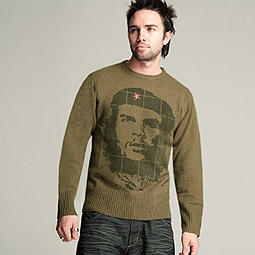
“This I call Fetishism which attaches itself to the products of labour, so soon as they are produced as commodities, and which already shown, in the peculiar social character of the labour that produces them” (777). –Marx & Engels

I was going to apply Jameson to literature for my blog (I apologize for not writing about literature this time), but Professor Zemka’s remarks about REM reminded me of the phenomenon of the commodification of the image of Ernesto “Che” Guevara, an Argentine-born Marxist revolutionary who fought with Fidel Castro in Cuba, as well as in the Congo and Bolivia. The image of Che itself has become a fetish, which adopts various meanings depending on the context. The image for this phenomenon originates in a 1960 photograph taken by Alberto Diaz Gutierrez—a.k.a. Alberto Korda—in Cuba, about a year after Castro’s ultimate success in achieving control of the government. In the photo, Che Guevara attends a memorial service for the casualties of what Castro called a counterrevolutionary attack upon Cuba backed by United States. (Claiming copyright over the Che image, Korda sued a vodka company in 2000 for its use of the image in a magazine ad). In this sense, the picture represents the perseverance of Castro’s communist government in the face of outside, capitalist forces. However, this representation changed when Che Guevara died in 1967—upon which he became a Marxist martyr—and his image from the photo was cropped and altered into the image that is spread so wide today. Although the initial image of Che was tied to rebellion, revolution, and Marxism, it has become a fetish and a commodity in our current climate, regardless of the intentions behind the image’s use.

To illustrate this, I will use the most popular of Che “products,” which is the t-shirt. A Che t-shirt, like any other t-shirt, is a commodity that masks the labor and conditions of those who produced it. The use of a Marxist “logo” to sell clothing produced in sweat-shop conditions creates a paradox in that the ideology of Marxism is tied to false-consciousness, and stamped upon a commodity that masks true class struggle. The Che image thus signifies something other than the Marxist revolutionary figure represented. The image becomes a fetish for the social relations of those who wear such clothing. Like Professor Zemka's example of the I-Pod Nano, the Che image on clothing is a signifier of “hip-ness” that represents the belonging to the larger community of the fashionably cool. In this sense, the image has been completely disassociated from the politics of Guevara and co-opted for capitalist gain.


 “This I call Fetishism which attaches itself to the products of labour, so soon as they are produced as commodities, and which already shown, in the peculiar social character of the labour that produces them” (777). –Marx & Engels
“This I call Fetishism which attaches itself to the products of labour, so soon as they are produced as commodities, and which already shown, in the peculiar social character of the labour that produces them” (777). –Marx & Engels I was going to apply Jameson to literature for my blog (I apologize for not writing about literature this time), but Professor Zemka’s remarks about REM reminded me of the phenomenon of the commodification of the image of Ernesto “Che” Guevara, an Argentine-born Marxist revolutionary who fought with Fidel Castro in Cuba, as well as in the Congo and Bolivia. The image of Che itself has become a fetish, which adopts various meanings depending on the context. The image for this phenomenon originates in a 1960 photograph taken by Alberto Diaz Gutierrez—a.k.a. Alberto Korda—in Cuba, about a year after Castro’s ultimate success in achieving control of the government. In the photo, Che Guevara attends a memorial service for the casualties of what Castro called a counterrevolutionary attack upon Cuba backed by United States. (Claiming copyright over the Che image, Korda sued a vodka company in 2000 for its use of the image in a magazine ad). In this sense, the picture represents the perseverance of Castro’s communist government in the face of outside, capitalist forces. However, this representation changed when Che Guevara died in 1967—upon which he became a Marxist martyr—and his image from the photo was cropped and altered into the image that is spread so wide today. Although the initial image of Che was tied to rebellion, revolution, and Marxism, it has become a fetish and a commodity in our current climate, regardless of the intentions behind the image’s use.
I was going to apply Jameson to literature for my blog (I apologize for not writing about literature this time), but Professor Zemka’s remarks about REM reminded me of the phenomenon of the commodification of the image of Ernesto “Che” Guevara, an Argentine-born Marxist revolutionary who fought with Fidel Castro in Cuba, as well as in the Congo and Bolivia. The image of Che itself has become a fetish, which adopts various meanings depending on the context. The image for this phenomenon originates in a 1960 photograph taken by Alberto Diaz Gutierrez—a.k.a. Alberto Korda—in Cuba, about a year after Castro’s ultimate success in achieving control of the government. In the photo, Che Guevara attends a memorial service for the casualties of what Castro called a counterrevolutionary attack upon Cuba backed by United States. (Claiming copyright over the Che image, Korda sued a vodka company in 2000 for its use of the image in a magazine ad). In this sense, the picture represents the perseverance of Castro’s communist government in the face of outside, capitalist forces. However, this representation changed when Che Guevara died in 1967—upon which he became a Marxist martyr—and his image from the photo was cropped and altered into the image that is spread so wide today. Although the initial image of Che was tied to rebellion, revolution, and Marxism, it has become a fetish and a commodity in our current climate, regardless of the intentions behind the image’s use. To illustrate this, I will use the most popular of Che “products,” which is the t-shirt. A Che t-shirt, like any other t-shirt, is a commodity that masks the labor and conditions of those who produced it. The use of a Marxist “logo” to sell clothing produced in sweat-shop conditions creates a paradox in that the ideology of Marxism is tied to false-consciousness, and stamped upon a commodity that masks true class struggle. The Che image thus signifies something other than the Marxist revolutionary figure represented. The image becomes a fetish for the social relations of those who wear such clothing. Like Professor Zemka's example of the I-Pod Nano, the Che image on clothing is a signifier of “hip-ness” that represents the belonging to the larger community of the fashionably cool. In this sense, the image has been completely disassociated from the politics of Guevara and co-opted for capitalist gain.
To illustrate this, I will use the most popular of Che “products,” which is the t-shirt. A Che t-shirt, like any other t-shirt, is a commodity that masks the labor and conditions of those who produced it. The use of a Marxist “logo” to sell clothing produced in sweat-shop conditions creates a paradox in that the ideology of Marxism is tied to false-consciousness, and stamped upon a commodity that masks true class struggle. The Che image thus signifies something other than the Marxist revolutionary figure represented. The image becomes a fetish for the social relations of those who wear such clothing. Like Professor Zemka's example of the I-Pod Nano, the Che image on clothing is a signifier of “hip-ness” that represents the belonging to the larger community of the fashionably cool. In this sense, the image has been completely disassociated from the politics of Guevara and co-opted for capitalist gain.



0 Comments:
Post a Comment
<< Home